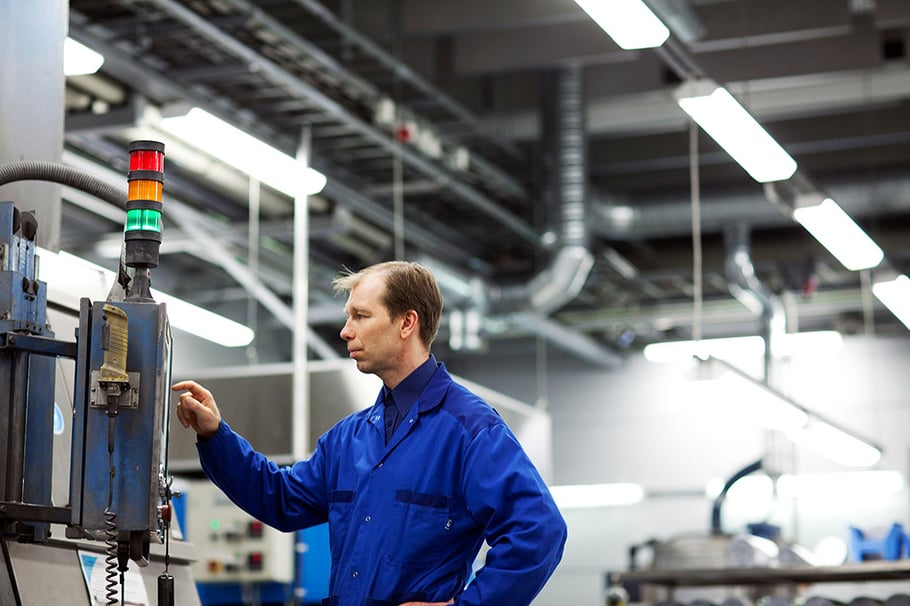
In perfect production, the machinery would run non-stop at full speed and there would be no quality losses. In real life, however, variations and deviations are part of the daily life of every production plant.
A clear operating model to combat disruptions
Disruptions challenge the company’s goals with respect to product quality, quantity, and time of delivery. Production efficiency plays a significant role in creation of company value and implementation of profitability.
In order to improve production efficiency, it should first be determined why production losses occur. In this context, losses refer to various needless and non-productive activities in production. The key to loss identification is measurement of what kind of requests for help are made in production and where they occur.
When this is determined, a quick and reliable flow of information must be established between the production and support functions. Once the actions above are completed, it is time to specify who and how reacts to requests for help.
On paper, the process sounds simple, but the reality is often quite different. Imprecise guidelines or time-consuming practices frequently lead to situations where the problem-solving process policy is vague and roles and responsibilities are not clear.
Does this situation sound familiar?
- Your machine is broken and you cannot fix it by yourself. You walk dozens of yards to the phone in order to call the maintenance unit.
- The first technician you call is busy. The other technician answers, but he is on his lunch break.
- At the same time, the shift supervisor interrupts his duties and comes to inquire why the machine does not run and why are the repairs taking so long. While you explain the situation to the shift supervisor, another colleague in need calls the technician you tried to contact first, who then engages in resolving a less critical problem with another machine.
- 45 minutes later, the technician returning from lunch happens to pass by and you manage to grab him by the sleeve and request for help.
What if the situation had played out this way?
- A machine is broken and you cannot fix it by yourself. Your production unit uses the Andon by Pinja system.
- You request help via your machine’s touchscreen. It takes 4 touches:
– Your request for help automatically triggers an alarm for both technicians.
– After the free technician hangs up the call, he acknowledges the request for help immediately.
– Based on additional information accompanying the request for help, he can bring along the right tools. - A request for help is visual and visible to all system users; this way, the shift supervisor can also see that although the machine does not run, help is already on the way. He can happily continue performing his own tasks.
- At the same time, another request for help is made to the maintenance unit from another machine, which the technician returning from lunch acknowledges and resolves. In this way, both failed machines are returned to production quickly and efficiently.
The above is just an example (albeit completely feasible!) of what kind of excessive work and idling trouble production day in, day out. The problem-solving process policy is vague and roles and responsibilities unclear. Management of support requests can also be confusing and time-consuming.
Using the Andon by Pinja system, requests for help can quickly be targeted to the right people, the situation made clear to the entire personnel, and transparency of the operations improved. In a nutshell, the system introduces a clear process for handling production disruptions and requests for help, rendering the data associated with production-related requests for help visible and measurable. Data collection allows identification of actual production bottlenecks and addressing the root causes of problems.

Mikko Tervala
I work as Key Customer Manager in productivity solutions at Pinja. My work days are spent with delivery projects and developing customer relationships. In my free time, I like to spend time with my family and exercise.
Back to the Pinja Blog
Categories
- Career at Pinja (68)
- Manufacturing (48)
- Knowledge Management (45)
- Production Development (44)
- Software Partnership & Tools (42)
- Sustainability (37)
- Wood and Forestry (37)
- Bioenergy and Recycling (27)
- IT Support and Outsourcing (24)
- Ecommerce (23)
- Maintenance (22)
- Artificial Intelligence and Machine Learning (15)
- Public Services (9)
- Compliance (1)